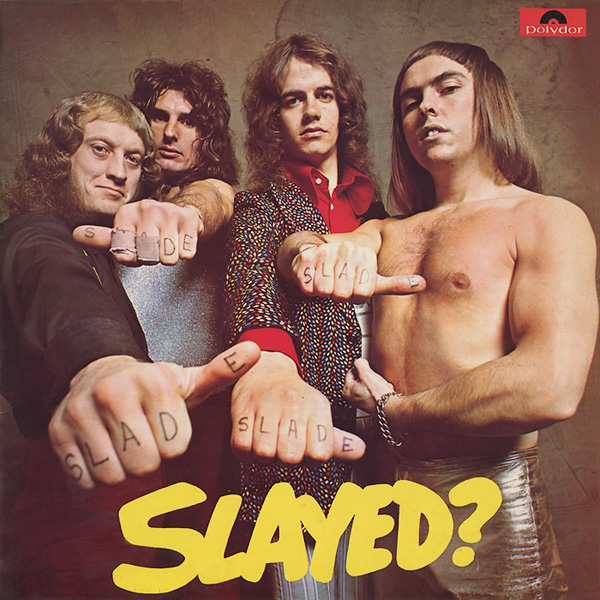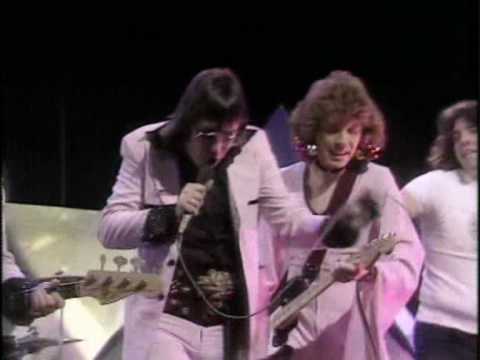
To understand the unique place that 1976 holds in the annals of popular music and culture, it is first necessary to reflect awhile on what had gone immediately before.
As the Summer of Love passed into the realms of ever more distant memory and the seemingly interminable 1960s – with its mods and rockers, beats and hippies, Godrock and flower power – finally passed over the baton to a new and uncertain decade, the quest by the restive young for something fresh, interesting and different was fulfilled by a pixie prince in a silver satin suit and a sprinkling of glitter beneath the eye. Whatever his sound had carried over from the late sixties, when Marc Bolan appeared on Top of the Pops with T. Rex performing his new single Hot Love in March 1971, the glam rock movement was born.
Glam’s displacement of all that had preceded it was as swift as it was complete. Within a year or so the singles charts came to be dominated by those acts which would define the genre. Slade, The Sweet, Gary Glitter, Suzi Quatro, Wizzard – acts such as these seemed almost to have booked a season ticket to the Top Ten. Both emerging and established acts – acts such as Elton John, Rod Stewart, even Elvis – adopted the look to at least some degree. The Osmonds, The Jackson Five, crooners like David Cassidy and indeed Donny, accepted the sequins, hair and flares as an obligatory feature of their respective repertoires. And then of course there was Bowie who, with his iconic Ziggy Stardust persona, took the whole thing onto another level.
Retro-glam
But glam was not a monolith, indeed by its very nature it was individualistic as each act set out to market its own distinctive brand. And soon the second generation of the movement, which came promptly in its wake, had a story all of its own to tell.
It is perhaps ironic that, having rescued us all from the hazy, and eventually dreary, psychedelia of the late 1960s, glam should then have looked for inspiration to a time which had preceded even that. All the same, before we quite knew it we were all of a sudden “remembering” the 1950s – despite the fact that very few of us, including the performers who urged us so to do, actually could.

This “retro-glam” sub-movement was pioneered by Mud, a four-piece combo that had already enjoyed chart success with the debut single Crazy and the follow-up Hypnosis before settling on a remodelled if slightly kitschy ’50s look, with singer Les Gray and most of his band kitted out in classic Teddy Boy garb, albeit with long hair, while lead guitarist Rob Davis remained defiantly faithful to glam, complete with perm, outrageous flares and chandelier earrings. Not very long afterwards they were followed into the fray by the Rubettes (“Do the Juke Box Jive, just like we did in 1955”), Alvin Stardust and Showaddywaddy. Even the Bay City Rollers, the bubblegum tartan teen idols with their very own line in period fashion, reminisced about an imaginary time when “We were all in the news with our blue suede shoes” (lead singer Les McKeown would have been precisely two months old when the Presley classic was first recorded). Those of us who remained emotionally wedded to our platforms had a torrid time at school from the wannabe teds with their ersatz brothel creepers that were in for a while, although generally they were worn with flares rather than the drainpipes of old.
End of an era
Alas it was all short-lived, and once the cult of remembering an era which none of us could remember had bored itself into extinction we were left with a pot pourri of slightly obsolete influences, all competing for relevance and credibility in what had become a much broader and deeper pond. Mud and Showaddywaddy retreated into the safe embrace of classic cover versions, Slade and The Sweet returned incrementally to their more organic rock roots, new acts like Cockney Rebel and Queen strove to disavow the glam label which they could see had pretty much reached its sell-by date, the pale and disquieting Thin White Duke was pining for Europe, Frampton came alive. And on top of it all came disco – and, it has to be said, of a quality hitherto unseen. When 1976 arrived we were all having a party, all the different genres happily coexisting in one glorious pre-punk celebration of everything the 1970s had thus far had to offer.
We knew it wasn’t going to last long, and once the New Wave had washed away all that had gone before many embraced it whilst others amongst our number mourned and sulked. And whilst a new age of disco in the form of the reborn Bee Gees and the Saturday Night Fever fad would not be long in coming, it would be somebody else’s age to enjoy.
1976, for many, was the end of an era. But what an era it was to have been a part of.

If you enjoyed reading this article, make sure you stay updated with all Phil’s latest blog posts by signing up to receive his free Newsletter. You can unsubscribe at any time and your details will never be shared with any third party. Click here to sign up today.